Sports and physical activities are an integral part of a healthy lifestyle. They provide numerous benefits, including improved cardiovascular health, better mental health, and increased overall physical fitness. However, sports also come with the risk of injuries, which can range from minor sprains to severe fractures. When athletes get injured, their primary goal is often to return to their sport as quickly and safely as possible. This is where the role of physiotherapy in sports injury rehabilitation becomes crucial.
Understanding Sports Injuries

Sports injuries can occur due to various reasons, such as improper training, lack of conditioning, inadequate warm-up, or even accidents during the activity. Common sports injuries include:
- Sprains and Strains: These are the most common sports injuries. A sprain occurs when ligaments (the tissue connecting bones) are stretched or torn, while a strain involves a muscle or tendon (the tissue connecting muscles to bones).
- Fractures: Broken bones often result from high-impact sports or falls.
- Dislocations: These occur when bones are forced out of their normal positions.
- Tendinitis: Inflammation of the tendons, often due to overuse.
- Bursitis: Inflammation of the bursae, small fluid-filled sacs that cushion the bones, tendons, and muscles near joints.
- Concussions: Traumatic brain injuries that affect brain function, commonly seen in contact sports.
The Role of Physiotherapy in Sports Injury Rehabilitation

Physiotherapy plays a vital role in the rehabilitation of sports injuries. The main goals of physiotherapy in sports rehabilitation are to:
- Relieve Pain and Inflammation: Initial treatment often focuses on reducing pain and inflammation. Techniques such as ice therapy, ultrasound, and electrical stimulation may be used.
- Restore Function: Rehabilitation aims to restore the normal function of the injured area. This includes regaining strength, flexibility, balance, and coordination.
- Prevent Re-Injury: Physiotherapists also focus on educating athletes about proper techniques and preventive measures to avoid future injuries.
Techniques Used in Sports Rehabilitation
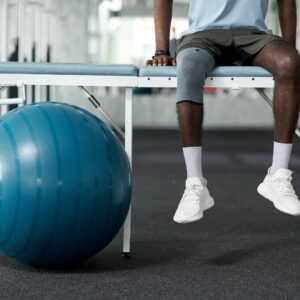
Physiotherapists employ a variety of techniques and modalities to help athletes recover from injuries. Some of the most common methods include:
- Manual Therapy

Manual therapy involves hands-on techniques to manipulate muscles, joints, and soft tissues. It includes:
- Massage: Helps in relieving muscle tension, reducing pain, and improving blood flow to the injured area.
- Joint Mobilization and Manipulation: These techniques help improve joint function and reduce pain.
- Myofascial Release: A technique that targets the fascia, the connective tissue surrounding muscles, to relieve tension and improve mobility.
- Exercise Therapy

Exercise is a cornerstone of sports injury rehabilitation. A well-designed exercise program can help restore strength, flexibility, and endurance. Exercise therapy includes:
- Range of Motion Exercises: These exercises help restore the normal movement of the injured joint or muscle.
- Strengthening Exercises: Targeted exercises to rebuild muscle strength around the injured area.
- Stretching: Helps improve flexibility and prevent stiffness.
- Balance and Proprioception Training: These exercises are crucial for athletes to regain coordination and prevent future injuries.
- Electrotherapy
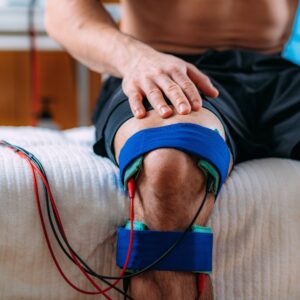
Electrotherapy uses electrical energy to promote healing and reduce pain. Common electrotherapy techniques include:
- Transcutaneous Electrical Nerve Stimulation (TENS): Helps in pain relief by stimulating the nerves.
- Ultrasound Therapy: Uses sound waves to promote tissue healing and reduce inflammation.
- Interferential Therapy (IFT): Helps in reducing pain and inflammation by stimulating deeper tissues.
- Cryotherapy and Heat Therapy

- Cryotherapy: The application of cold packs to reduce inflammation and numb pain.
- Heat Therapy: The application of heat to relax muscles, increase blood flow, and alleviate pain.
- Hydrotherapy
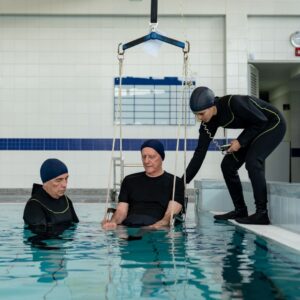
Hydrotherapy involves exercises performed in water. The buoyancy of water reduces stress on the joints and muscles, making it an excellent medium for rehabilitation exercises, especially in the early stages of recovery.
- Kinesio Taping
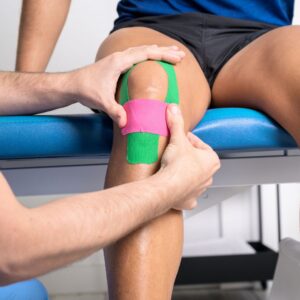
Kinesio taping involves the application of special tape to support muscles and joints without restricting movement. It can help reduce pain, improve circulation, and support the injured area during activity.
Case Studies in Sports Rehabilitation
Case Study 1: Ankle Sprain in a Basketball Player
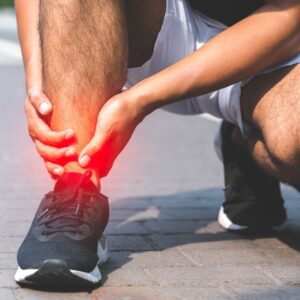
Background: A 20-year-old basketball player suffered a grade II ankle sprain during a game.
Initial Treatment: The initial treatment included rest, ice, compression, and elevation (RICE) to reduce swelling and pain.
Physiotherapy Intervention:
- Manual Therapy: Joint mobilizations to restore ankle movement.
- Exercise Therapy: Range of motion exercises, followed by strengthening exercises for the ankle muscles.
- Balance Training: Exercises on a balance board to improve proprioception and prevent future sprains.
- Education: The physiotherapist educated the player on proper warm-up techniques and ankle taping to prevent re-injury.
Outcome: The player returned to full activity within six weeks, with no recurrent sprains reported in the following season.
Case Study 2: ACL Reconstruction in a Soccer Player

Background: A 25-year-old soccer player underwent anterior cruciate ligament (ACL) reconstruction surgery after a knee injury.
Physiotherapy Intervention:
- Post-Surgery Phase: Controlled range of motion exercises to prevent stiffness and promote healing.
- Strengthening Phase: Progressive strengthening exercises for the quadriceps and hamstrings.
- Functional Training: Sport-specific drills and exercises to restore agility and coordination.
- Return to Play: Gradual return to soccer drills, with a focus on technique and movement patterns to avoid re-injury.
Outcome: The player successfully returned to competitive soccer nine months post-surgery, with full strength and function restored.
Preventive Measures and Education
One of the key roles of physiotherapists in sports rehabilitation is to educate athletes on injury prevention. This includes:
- Proper Warm-Up and Cool-Down: Emphasizing the importance of warming up before activities and cooling down afterward to prevent injuries.
- Correct Technique: Ensuring athletes use the correct techniques in their sport to avoid unnecessary strain on their bodies.
- Appropriate Equipment: Advising on the use of appropriate footwear and protective gear.
- Conditioning Programs: Designing conditioning programs to improve overall fitness and reduce the risk of injuries.
The Future of Physiotherapy in Sports Rehabilitation
The field of physiotherapy is constantly evolving, with new research and technologies shaping the future of sports rehabilitation. Some emerging trends include:
- Tele-rehabilitation: The use of digital platforms to provide remote physiotherapy sessions, making it easier for athletes to receive care regardless of their location.
- Wearable Technology: Devices that monitor movement and provide real-time feedback can help physiotherapists design more effective rehabilitation programs.
- Regenerative Medicine: Advances in regenerative medicine, such as stem cell therapy and platelet-rich plasma (PRP) therapy, show promise in enhancing the healing process of sports injuries.
Conclusion
The role of physiotherapy in sports injury rehabilitation is multifaceted, involving pain relief, functional restoration, and injury prevention. Physiotherapists use a variety of techniques, from manual therapy to exercise therapy, to help athletes recover and return to their sport safely. The ultimate goal is not only to treat the injury but also to prevent future injuries by educating athletes and promoting overall physical health.
For students pursuing a Bachelor of Physiotherapy, understanding the critical role of physiotherapy in sports injury rehabilitation is essential. This knowledge not only prepares them for a rewarding career in sports physiotherapy but also equips them with the skills to make a significant impact on the health and performance of athletes.
College Forum is an excellent platform for students to explore the best colleges that offer comprehensive physiotherapy programs. With access to top-tier education and state-of-the-art facilities, aspiring physiotherapists can gain the knowledge and experience needed to excel in this dynamic and fulfilling field.

